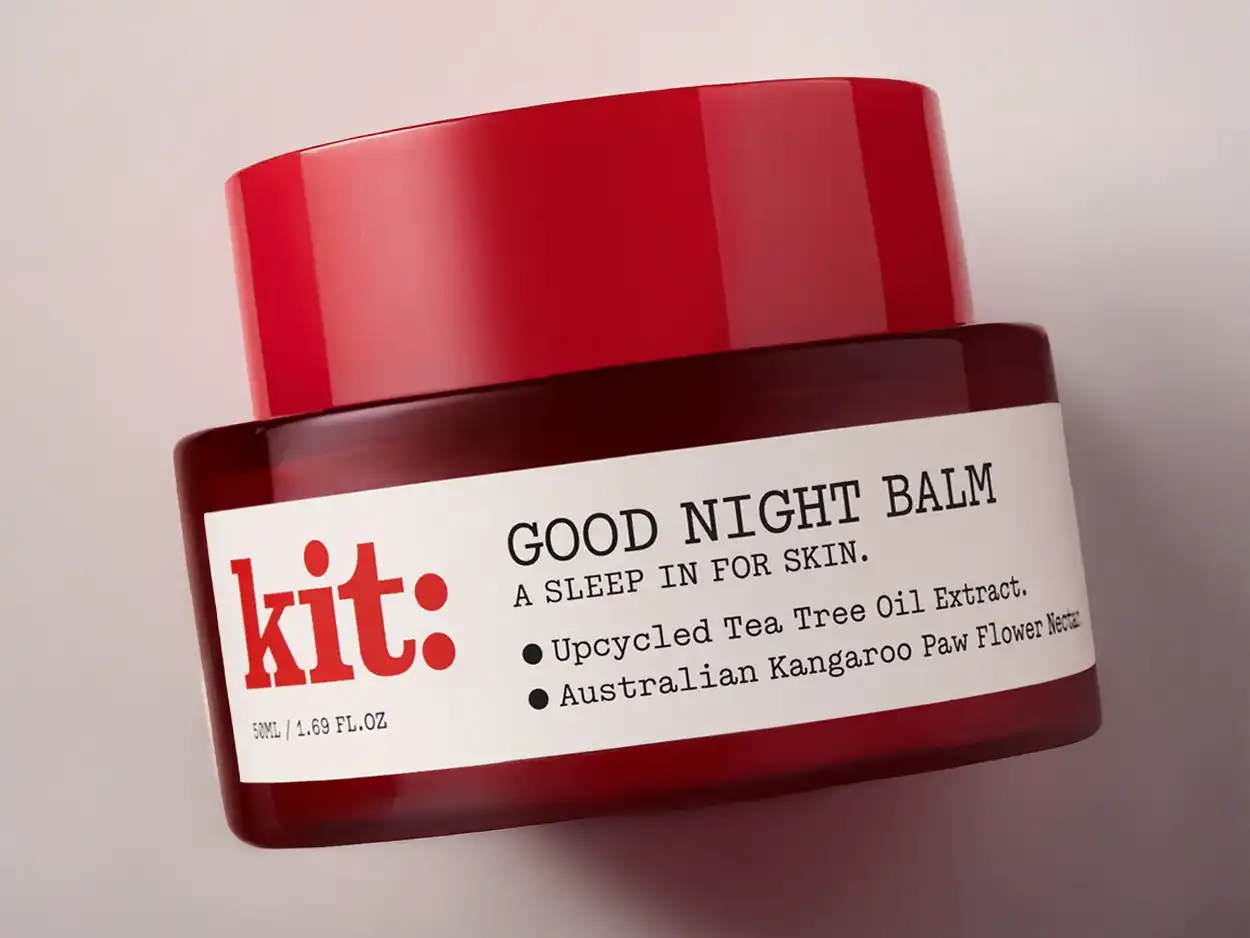Kit: may not have the global clout of the century old French maisons but among skincare insiders its quietly rigorous formulations and no nonsense aesthetic have earned a loyal following in Australia. The Aussie-owned brand seems to thrive on the sweet spot between apothecary roots and modern lab savvy, which explains why its launches tend to spark curiosity faster than you can say waitlist.
The latest to land on my nightstand is the cheerfully named Good Night Balm, billed by Kit: as a tea tree enriched sleep-in treatment suitable for every complexion. The promise is simple yet ambitious: massage it into freshly cleansed skin, drift off and wake up to a visage that feels firmer smoother and more hydrated, all while enjoying a meditative bouquet that starts with myrrh rosemary and galbanum then mellows into minty lavender eucalyptus before settling into sandalwood amber and vetiver. A bedside aromatherapy session disguised as skincare, at least on paper.
I gave the balm a full two week whirl, alternating between humid city nights and aggressively air-conditioned ones, to gauge how well it lives up to that dreamy script and whether it deserves a spot in your routine or just your Instagram feed.
Disclaimer: this is not a paid or sponsored review. The product was tested independently and all opinions are entirely my own. As with any skincare, individual results can and will vary.
What Is Good Night Balm?
Good Night Balm is an overnight treatment, meaning it is built to sit on the skin for a full sleep cycle and do the heavy lifting while you rest. Overnight treatments differ from standard night creams because they tend to be richer, form a gentle occlusive layer and are loaded with active ingredients that benefit from extended contact time. In practical terms you apply them as the very last step after cleansing and any serums, then leave them untouched until your morning wash.
This particular balm targets all skin types and centers its formula on tea tree oil for its purifying edge, backed by emollient butters, plant oils and humectants that aim to lock in moisture and temper overnight water loss. The brand’s instructions are straightforward: massage a small amount into clean skin in the evening and let the botanicals get to work until dawn.
Fragrance plays a supporting role here as well. The scent moves from resinous myrrh and rosemary through a mint-lavender middle into a woody sandalwood vetiver dry down, intended to create a calming pre sleep moment. Strip away the aroma and you are left with a functional barrier booster that promises firmer, smoother and better hydrated skin by morning, slotting neatly into the space where you might otherwise reach for a thicker night cream or sleeping mask.
Did It Work?
In the name of rigorous journalism I temporarily benched my usual overnight treatment for the first three days so Good Night Balm could bask in the spotlight all by itself, a highly scientific maneuver that involved dramatic shelf shuffling and a solemn promise to resist old habits. Fourteen nights felt like a fair window to judge whether the claims of firmer smoother and better hydrated skin would materialize or fizzle out with the last note of sandalwood.
Application was a small nightly ritual: a pea sized amount warmed between fingers then pressed and lightly massaged across face and neck. The texture sits somewhere between custard and salve, melting down quickly but leaving a satiny film that never fully dries. Night one I noticed a subtle tea tree tingle around the chin, nothing alarming yet definitely present. By morning my skin looked calm and pleasantly dewy though not dramatically transformed. No clogged pores or irritation showed up, a relief since rich balms can sometimes trigger unwelcome visitors on my combination complexion.
Nights three through seven were the honeymoon phase. The balm consistently locked moisture in so I woke up to that soft plush feeling usually reserved for post facial mornings. Makeup slid on easier too thanks to the smoothing layer left behind. The herbaceous fragrance became part of my wind down cue, less spa incense and more botanical garden at dusk, and I found myself inhaling it like a pre sleep meditation.
Week two told a slightly different story. Hydration remained solid yet incremental improvements plateaued. Skin felt cushioned but the promised firmness bump was hard to quantify and any glow came primarily from the occlusive finish rather than a deeper renewal. On two particularly humid nights the finish verged on sticky and I caught myself blotting my T zone before bed, a move that somewhat defeats the purpose of a leave on treatment.
By day fourteen my verdict was clear: Good Night Balm is a dependable moisturizer that excels at preventing overnight dehydration and offers a comforting sensorial experience. It half delivers on smoothness, mostly misses on visible firming and provides hydration in a way that is pleasant rather than spectacular. I respect its consistency and gentle nature yet I will be returning to my usual heavyweight that gives me more noticeable bounce. If you crave a soothing nightly cocoon and can tolerate a lingering film you may well adore it, I just will not be carving out permanent shelf real estate for it.
Good Night Balm’s Main Ingredients Explained
Tea tree oil headlines the formula at a skin friendly concentration, bringing its well documented antimicrobial talent to curb the nighttime bloom of blemish causing bacteria. The brand buffers the potentially sharp edge of tea tree with a trio of lipid rich emollients: olive derived squalane for featherlight lubrication, jojoba seed oil that mimics sebum and sesame oil that seals moisture while lending a soft sheen. Together they create that occlusive veil I felt every morning, slowing transepidermal water loss without feeling like a wax coat.
Hydration is further propped up by classic humectants glycerin, butylene glycol and a xylitol complex that pull water into the upper layers so skin stays plump. Shea butter appears midway down the list, gifting a dosage of stearic and oleic acids that smooth rough patches though it is rated moderately comedogenic. In practical terms that means it can clog pores for some, especially on oilier skin that already struggles with congestion. If you are prone to acne, patch testing is wise.
The balm’s cushiony texture relies on sugar derived sucrose polystearate and cetearyl alcohol, fatty alcohols that thicken while also acting as emollients. No silicones here, instead the slip comes from plant based esters like coco caprylate. Preservatives are minimal yet effective: phenoxyethanol and hydroxyacetophenone keep microbes at bay without the controversy that trails parabens.
On the aromatic side a cocktail of essential oils delivers that spa adjacent scent but also introduces common fragrance allergens such as linalool, limonene and citral. Sensitive noses or dermatitis prone skin should take note since repeated exposure can spark irritation even in an otherwise gentle base.
The ingredient list is free of animal derived materials so the balm checks the box for both vegans and vegetarians. However pregnancy calls for extra prudence. Essential oils including rosemary and myrrh fall into the caution category during gestation so it is best to consult a healthcare professional before adding this to a prenatal routine.
One last tidbit: the formula avoids heavy occlusives like petrolatum making it breathable enough for most climates yet that also means the hydration payoff hinges on diligent nightly use. Skip a night and the plush factor drops quickly which partly explains the respectable though not stellar score on my ledger.
What I Liked/Didn’t Like
After two weeks of nightly use, here is the straightforward breakdown.
What Works Well:
- Keeps moisture locked in through the night so skin feels soft and cushioned at sunrise
- Mild tea tree presence provides a purifying touch without tipping into irritation for most skin types
- Gentle ingredient list with antioxidants peptides and low comedogenic oils suitable for most skin types
What to Consider:
- Occlusive film can feel tacky in high humidity and may tempt blotting
- Firming claim is subtle at best so those chasing visible lift might be underwhelmed
- Essential oil fragrance plus common allergens like linalool and limonene may not suit very reactive skin
My Final Thoughts
Two weeks in, Good Night Balm sits comfortably in the realm of solid-but-not-spectacular. It nails overnight cushioning, keeps fickle hydration levels on the straight and narrow and smells like an herb garden performing lullabies. What it does not quite hit is the firmer skin crescendo its marketing sheet hints at, at least not in a way my mirror could applaud. I have cycled through more nocturnal formulas than I care to confess so I feel confident this 7.5/10 score is a fair reflection rather than tough love for the sake of it.
Who will love it? Anyone whose skin flips between oily and dry seasons yet craves a botanical wrap that is lighter than a sleeping mask but richer than a gel. Also fans of essential oil aromatherapy who enjoy a soft veil lingering until sunrise. Who might pass? Heat-prone complexions that despise any tack and firmness chasers who want a bouncy, selfie-ready payoff by breakfast.
Would I recommend it to a friend? Yes, but with caveats. If your main battle is moisture loss and you relish a sensory wind-down, go ahead and scoop. If lifting and tightening are your north star, I would steer you toward something with heftier actives.
Speaking of alternatives, my bedside drawer has recently been courting a few other contenders that you might find intriguing. Nocturnal Revive Cream by Deascal is an impressively balanced all-rounder that hydrates, calms and lightly refines at a wallet-friendly price. For a plush yet springy finish the Bouncy & Firm Sleeping Mask by LANEIGE earns high marks, especially when humidity spikes. Those chasing a dash of luxury should consider Pro-Collagen Night Cream by ELEMIS which softens lines with a satisfying cream-to-silk glide. Finally, sensitive souls can lean on Toleriane Dermallergo Night Cream by La Roche-Posay which pares back fragrance but still delivers overnight comfort. I have rotated through all four and each brings its own flavour of beauty sleep insurance.
Before you dive in (and forgive me for sounding like an over-protective parent) remember the basics: patch test any new formula, give it a sensible run before judging and keep expectations tethered to reality. Results will stick around only if you do, so consistent use is non-negotiable.

